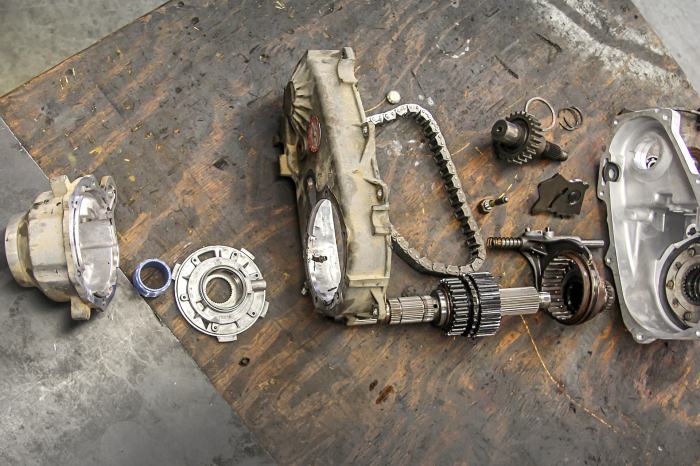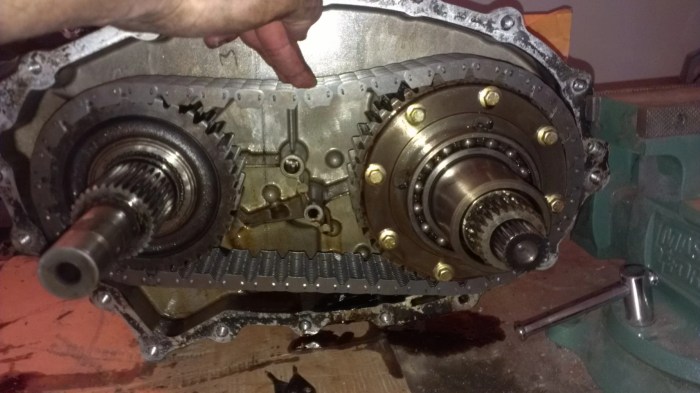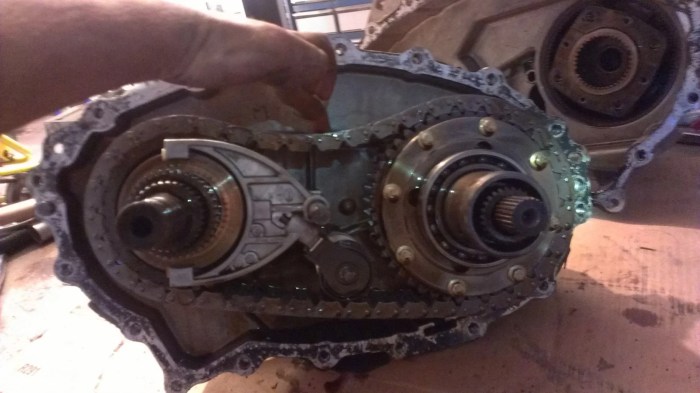When disassembling a chain drive type transfer case remove the – When disassembling a chain drive type transfer case, removing the chain drive is a crucial step. This process requires careful attention to detail and an understanding of the components involved. This guide will provide a comprehensive overview of the steps, tools, and techniques necessary for successful chain drive removal.
Understanding the intricacies of chain drive removal is essential for ensuring proper maintenance and repair of transfer cases. By following the guidelines Artikeld in this guide, individuals can effectively disassemble and remove the chain drive, paving the way for further inspection, assessment, and potential repairs.
Removal of Transfer Case Chain Drive

The removal of a chain drive from a transfer case is a complex process that requires specific tools and expertise. This guide will provide a step-by-step explanation of the disassembly procedure, including the tools and equipment required.
Tools and Equipment
* Transfer case chain drive removal tool
- Socket wrench
- Torx wrench
- Hammer
- Screwdriver
- Pliers
- Safety glasses
- Gloves
Disassembly Procedure
- Disconnect the negative battery terminal.
- Remove the driveshaft from the transfer case.
- Remove the oil pan from the transfer case.
- Remove the chain drive cover bolts.
- Carefully lift the chain drive cover off the transfer case.
- Remove the chain drive sprocket bolts.
- Remove the chain drive sprocket from the transfer case.
- Remove the chain drive chain from the sprockets.
Inspection and Assessment: When Disassembling A Chain Drive Type Transfer Case Remove The

Once the chain drive has been removed, it is important to inspect the components for signs of wear, damage, or defects. This includes checking the chain for stretched links, broken pins, or excessive wear. The sprockets should also be inspected for damaged teeth or excessive wear.If
any significant wear or damage is found, the chain drive should be replaced. If the wear or damage is minor, the chain drive may be able to be repaired.
Signs of Wear and Damage, When disassembling a chain drive type transfer case remove the
* Stretched links
- Broken pins
- Excessive wear on the chain
- Damaged teeth on the sprockets
- Excessive wear on the sprockets
Cleaning and Maintenance
After the chain drive has been inspected, it is important to clean the components thoroughly. This will help to remove any dirt, debris, or oil that may have accumulated on the parts. The chain should be cleaned with a degreaser and a brush.
The sprockets should be cleaned with a wire brush.Once the components have been cleaned, they should be lubricated with a high-quality chain lubricant. This will help to reduce friction and wear on the chain and sprockets.
Lubrication Requirements
* High-quality chain lubricant
Apply lubricant to the chain and sprockets
Reassembly and Installation

Once the chain drive components have been cleaned and lubricated, they can be reassembled. The reassembly process is the reverse of the disassembly process.When reassembling the chain drive, it is important to ensure that the chain is properly tensioned. The chain should be tight enough to prevent it from slipping, but not so tight that it puts excessive stress on the sprockets.
Torque Specifications
* Chain drive sprocket bolts: 25-30 ft-lbs
Chain drive cover bolts
10-15 ft-lbs
Troubleshooting and Repair
If you are experiencing problems with your chain drive transfer case, there are a few things you can check. First, check the fluid level in the transfer case. If the fluid level is low, add fluid until it reaches the full mark.If
the fluid level is correct, check the chain for wear or damage. If the chain is worn or damaged, it will need to be replaced.If the chain is not worn or damaged, check the sprockets for wear or damage. If the sprockets are worn or damaged, they will need to be replaced.
Common Problems
* Low fluid level
- Worn or damaged chain
- Worn or damaged sprockets
FAQ
What are the common signs of a worn chain drive?
Excessive noise, slipping, or difficulty shifting gears can indicate a worn chain drive.
How often should a chain drive be inspected?
Regular inspections are recommended every 30,000 to 50,000 miles, or as per the manufacturer’s guidelines.
Can a chain drive be repaired or must it be replaced?
Depending on the extent of damage, a chain drive may be repairable. However, severe wear or damage may necessitate replacement.